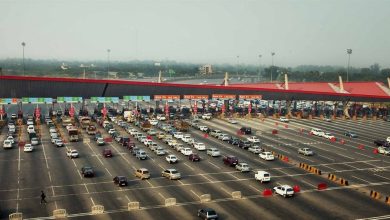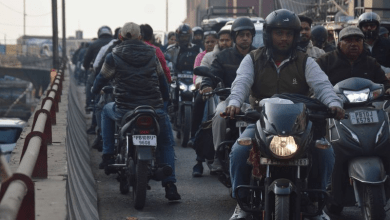Nagpur Traffic Department Introduces On-Street Parking to Ease Congestion

Nagpur Traffic: In an effort to tackle the ever-growing problem of traffic congestion and chaotic parking on Nagpur’s busy roads, the city’s Traffic Department has announced the implementation of on-street parking across 11 key locations. This new initiative is set to make a big impact on how traffic flows in these areas and promises to create a smoother experience for both drivers and pedestrians.
What’s the New Plan?
The Deputy Commissioner of Police (Traffic), Archit Chandak, recently rolled out a notification explaining the new on-street parking model. The plan includes specific zones for parallel parking to be tried out on an experimental basis. The ultimate goal is to make sure that vehicles are parked in a more orderly fashion, ensuring better movement of traffic and reduced congestion.
But how does it work? Let’s break it down.
Designated Parking Zones (Nagpur Traffic)
The plan details several key areas across the city where parallel parking will be allowed. Some roads will only permit parking on one side, while others will allow it on both. In a move to keep things organized, two-wheelers will have their own designated areas on certain stretches of road.
- Orange City Square to RPTS Square: Parking is allowed on the left side of the road only.
- Mangalmurti Square to London Street: Both sides of the road are open for parallel parking.
- Shankar Nagar Square to Laxmibhavan Square: This stretch will be reserved strictly for two-wheelers.
Let’s look at more locations that will adopt this parking model.
Additional Routes for On-Street Parking (Nagpur Traffic)
The following routes will also accommodate parallel parking on both sides of the road:
- Manewada Road to Tukdoji Square
- Tukdoji Square to Rajkamal Square
- Medical Square to the Dead End
- Baidyanath Square to Ashok Square
- Bhande Plot Square to Jagnade Square
- Rani Durgavati Square to Marwadi Square
- Vaishnodevi Square to Prajapati Square
- Vaishnodevi Square to Shastri Nagar Square
These zones were chosen because of their heavy traffic and consistent parking issues. Implementing on-street parking here is expected to not only help drivers but also reduce the headache for pedestrians trying to navigate crowded sidewalks.
Why Is This Necessary?
Nagpur’s traffic has been getting more and more congested as the city continues to grow. With more people owning vehicles and the city’s infrastructure struggling to keep up, chaotic parking has become a major issue. Double parking, vehicles left on sidewalks, and blocked intersections are all too common on some of Nagpur’s busiest roads.
The on-street parking initiative hopes to bring some order to this chaos. By providing clear parking zones and enforcing rules, the city’s traffic department is taking a step towards smoother traffic flow and a more organized city.
A Positive Move for Traffic Flow (Nagpur Traffic)
Not only will this plan reduce the confusion of where to park, but it will also help traffic move more freely. Often, vehicles parked haphazardly on the road lead to jams that could have been avoided with better organization. With designated spots and rules, drivers will know exactly where they can leave their vehicles, and the chances of obstructing traffic will drop significantly.
Experimental Phase: Testing the Waters
It’s important to note that this plan is still in its experimental phase. The Traffic Department is keeping a close eye on how well these measures work and whether they bring the desired relief from traffic congestion. Feedback from the public will also play a crucial role in determining the future of this parking model.
Why an Experimental Approach?
Parking in a city like Nagpur comes with its own set of challenges. By rolling out this plan experimentally, the Traffic Department can monitor and adjust accordingly without causing major disruptions. If all goes well, the on-street parking model could be expanded to more areas.
Impact on Drivers and Businesses
The introduction of on-street parking is likely to have a significant impact on both drivers and local businesses. For drivers, finding a parking spot will be less of a guessing game, reducing the time spent circling around blocks. For local businesses, this initiative could mean more customers, as people will find it easier to park and access shops without worrying about fines or tows.
Will This Solve All Parking Problems?
While on-street parking is a step in the right direction, it’s not a silver bullet. The city still faces issues like a growing number of vehicles and limited road space. However, this plan can serve as a foundational improvement that could inspire further reforms in urban planning and traffic management.
What’s Next for Nagpur’s Traffic Department?
If the on-street parking model proves successful, we could see similar efforts in other parts of the city. More roads could adopt this system, and new policies might be introduced to further streamline parking and traffic flow.
The Traffic Department is also likely to work closely with other civic bodies to ensure that proper signage, road markings, and parking enforcements are in place. This collaboration will be key to making the experiment a success and turning it into a permanent solution.
Long-Term Benefits
Implementing well-organized parking can have lasting positive effects. Over time, we could see fewer traffic jams, safer streets for pedestrians, and a more pleasant driving experience. In the long term, better parking management might also encourage more people to use public transportation, further reducing the strain on the city’s roads.
The Nagpur Traffic Department’s move to introduce on-street parking is a smart, strategic step towards addressing the city’s traffic woes. Although the initiative is still in its experimental phase, it shows promise in bringing much-needed relief to some of Nagpur’s busiest roads. By organizing parking and managing traffic flow, the department aims to ease congestion and improve the overall driving and pedestrian experience in the city.
1. How will on-street parking benefit Nagpur’s traffic situation?
The on-street parking model is designed to reduce chaotic parking and ensure smoother traffic flow by providing designated zones for vehicles.
2. Is this on-street parking model permanent?
No, the model is currently being implemented on an experimental basis. Its long-term adoption will depend on its success during this trial phase.
3. Will parking be free in these designated zones?
The notification doesn’t specify whether there will be charges for parking. This could be determined as the experiment progresses.
4. Which vehicles are allowed in the on-street parking zones?
Most areas will accommodate all vehicles, but some stretches, like the one from Shankar Nagar Square to Laxmibhavan Square, are reserved for two-wheelers only.
5. What happens if the experiment is not successful?
If the trial doesn’t meet expectations, the Traffic Department may adjust the plan or discontinue it. Public feedback will be an essential part of this decision.









